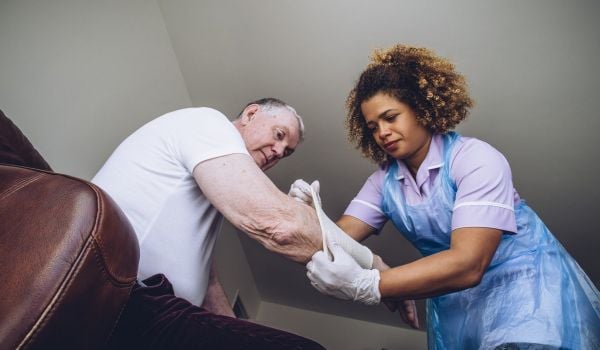“The tall young doctor didn’t mind touching patients,” reads a chapter in Kathryn Boo’s Behind the Beautiful Forevers. “He came one night and stretched out one of Fatima’s arms, and then the other, and when he did so, her bandages, which had turned yellow and black, came loose.”
Fatima is a woman who had burned herself in protest. Boo’s book, a nonfiction account of life in a Mumbai slum, documents the infection that swiftly ends her life after her hospitalization in a facility where no medicine is available.
The book presents a true but grim view of the large, complex and densely populated subcontinent. The nameless doctor walks in and out of the sprawling story on a single page. Yet zooming in on that clinician would reveal a whole other tale — one that unfolds on the white coat he wears, one that can only be seen with a microscope.
The pathogens harbored on a coat meant to signify cleanliness that can end a patient’s life. That’s why, in an op-ed published last week in British scientific journal BMJ, Mangalore-based public health physician Edmond Fernandes advocates removing the white coat for good.
Dark cloaks were once the norm for physicians. They signified the formality that defined medical care, and hid the fluids that sometimes flowed during patient care. But a growing understanding of the spread of infectious disease heralded the advent of white coats. The garment was thought to telegraph a clinician’s cleanliness. It’s been standard in the West for over a century.
The problem, Fernandes points out, is that that unstained expanse of fabric gives the perception of cleanliness — beneath which lives a teeming population of potentially deadly microorganisms invisible to the naked eye. “Today we know that white coats harbour potential contaminants and contribute considerably to the burden of disease acquired in hospital by spreading infection,” he writes.
To Fernandes, the solution is simple: Get rid of the white coat entirely. In an interview this week, he described the “mortal perils” of the white coat, asking, “Can we do something to swallow our egos and provide more appropriate patient care?”
In fact, the ego might be the largest factor impeding the idea from taking hold. For over a century, the coat has been a potent symbol of the prestige of medical practice. Many medical schools initiate their incoming classes with a “white coat ceremony.”
Surgeon-writer Atul Gawande has noted that the coat has a psychological effect on the wearer. “Somehow,” he writes, the idea that he was mortal “didn’t occur to me, even when I saw people my own age die. I had a white coat on; they had a hospital gown. I couldn’t quite picture it the other way round.” In a hectic working life spent face-to-face with pain, suffering, and death, a separation between patient and clinician can be a self-preserving move.
Fernandes has found a third example of white coats as a symbol of the ego. He explained that his BMJ op-ed had been motivated by another article — an op-ed for an Indian newspaper on physicians wearing their white coats in public, all the time, as an apparent signifier of their social status. Saying that the practice could spread infectious pathogens among the general public, that article labeled the phenomenon “white coat syndrome.”
The same term used to mean something entirely different: a patient’s fearful response to physicians clad in white coats. Whether a response to a doctor’s power or a trigger for feelings about the impact of illness, patients are known to experience anxiety, hypertension and other adverse reactions in the presence of clinicians. In a weird way, Indian physicians’ wearing of coats in public might reduce this original white coat syndrome — by breeding familiarity with physicians as ordinary people about town — even if the intention is just the opposite.
But in other ways, ditching the coat would be a helpful move. Alternative items (like stethoscopes) are easier to sterilize but are just as evocative of medical practice, and the anesthetic of emotional distance, if understandable, can ultimately reduce quality of care. Fernandes acknowledged that, “in India, there are no statistics for HAIs [hospital-acquired infections], so it’s like the [tip of the] iceberg phenomenon.” Nonetheless, he cites pertinent research that the majority of physicians’ coats are contaminated with microbes — the full gamut of which encompasses Staphylococcus aureus, enterococcus, and myriad other species — that can seriously harm or kill a patient.
Although the problem of contamination extends beyond white coats to other clothing, bedding, surfaces and even air flow through hospitals, removing the coat would be a step forward — an improvement, for instance, on the advice that Boo’s unnamed doctor offered Fatima on her deathbed.
“Something’s wrong,” Boo quotes her in her sole conversation with the doctor. “I’m so cold.”
“Drink three bottles of water a day,” the doctor offers, ignoring a sign of fulminating infection. He returns her filthy bandages to her wounds and walks out of the room, clad in white and yet impure.
The “Health Horizons: Innovation and the Informal Economy” column is made possible with the support of the Rockefeller Foundation.

M. Sophia Newman is a freelance writer and an editor with a substantial background in global health and health research. She wrote Next City's Health Horizons column from 2015 to 2016 and has reported from Bangladesh, India, Nepal, Kenya, Ghana, South Africa, and the United States on a wide range of topics. See more at msophianewman.com.
Follow M. Sophia .(JavaScript must be enabled to view this email address)

















